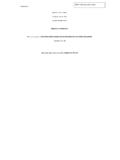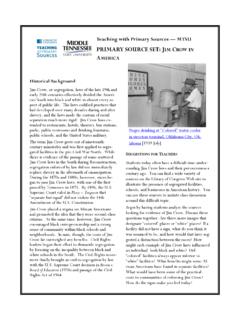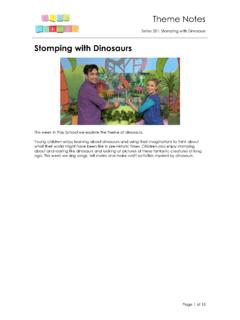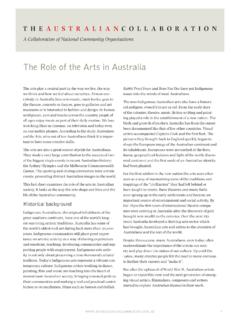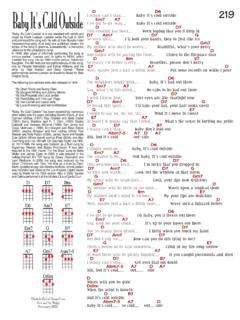Transcription of Post-digital Aesthetics and the return to Modernism
1 Post-digital Aesthetics and the return to ModernismWhat is it that constitutes (a) Post-digital art, and how can it be thought in terms ofaesthetic theory or even post - aesthetic theory?In one sense, post -digital1 refers to works that reject the hype of the so-called digitalrevolution. The familiar digital tropes of purity, pristine sound and images and perfectcopies are abandoned in favour of errors, glitches and artefacts. And in another sense (asin the term post - Modernism ) it refers to the continuation or completion of that music incudes a number of sub-genres: glitch, clicks & cuts, microsound,headphonics, etc. All are, more or less, concerned with the foregrounding of the flawsinherent in digital processes. This valorisation of what previously would have been seenas noise: a by-product, bearing an external relation to the work, would be one of thecharacterising marks of a Post-digital aesthetic . An aesthetic made up of minuscule stabsof sound, clicks, glitches, buzzes, light airy drones and hisses, mangled ring-modulatedtones and grainy clouds of , can we say that this aesthetic is preceded by a digital aesthetic ?
2 If there is such an aesthetic position it surely tied to the digital technological trajectory the idea of digital progress. This trajectory involves (in at least one of it s channels) ateleological movement toward perfect representation. This is both a technologicalmovement towards transparency and, at the same time, a movement towards morepowerful the initial claims of perfection were put into doubt, digital technology (at least inthe realm of music production) began to emulate, as much as possible analogue soundand technologies. The analogue sound, although considered to be not as clean anddigital, was felt to be warmer and fatter than its digital So it seems,paradoxically, that digital music (as such), or music of the digital age, since it has beenconcerned primarily with the transparency of production, in the form of pristine soundreproduction (a quality based on an absence or negation), has developed an analogueaesthetic.
3 On the other hand, Post-digital music has developed distinctly digital aesthetic , one that centres around sounds and timbres that could only be possible withcontemporary digital equipment certainly, but also one that resists the trajectory ofmainstream software marketing. Thus it can be seen how easily these terms analogueaesthetic, digital aesthetic , Post-digital music, offer a number of Post-digital aesthetic is by no means confined to electronic/computer musicproduction. A similar shift, at the same time, has occurred across a number ofinterrelated disciplines: video art, , graphic design, etc. Post-digital art can be seento be a reaction to a crisis in post -modern culture: a culture problematised by endlesswebs of mediatic allusion, media saturation, and a kind of abyssal reaction often takes the form of a (naive) return to the purity of Modernism . A flightaway from the complex problematics of a period of crisis and toward the cosy certaintiesof an earlier age, or at the very least, a retreat from socio-political issues to a refuge inscientific concepts and of the hallmarks of modernist art movements is the manifesto.
4 Two such manifestoeshave emerged this year (2002): Eryk Salvaggio s Six Rules of ,3 and LevManovich s Generation Flash (more an essay but it reads like a manifesto).4 Bothpropose the development of a new aesthetic for digital art ( in Salvaggio s case).Manovich even advocates a return to Modernism as the first step towards thedevelopment of a new theorises this shift away from post - Modernism around the problem of theoriginality and uniqueness of content; the problem of the parasitic relation between themedia artist and her/his years of media art and post - Modernism have inevitably led to a reaction. We aretired of taking existing media as a starting point. We are tired of being always secondary;always reacting to what already rejection of the recombinant media strategies of re-use, appropriation, media-critique, re-presentation, cut-up, deconstruction, etc. (often all lumped under theumbrella term: post - Modernism ) is central to both arguments.
5 It may be that there arevery good arguments for the abandonment of certain post -modernist practices. Forexample, the growing sophistication of television s own self parody, and also thealarming speed at which the advertising media reappropriate the style, and even thecontent, of media art, would tend to render a substantial body of work in this direction asfutile. Then again there is the problem of kitsch and camp forms of critique, humour,parody and pastiche that became so prevalent in so-called postmodernist art (now at leasthalf of Hollywood s yearly output consists of remakes of camp classics). If there was anysubversion inherent in kitsch it has now been well exhausted. The return to the singularityof Modernism does seem tempting, if indeed only as a first terms of Aesthetics this return is, already, well under way. The manifestoes havearrived after the fact. In web-based digital art we see, as Manovich remarks, abstractgeometrical forms, pixel thin lines, delicate but simple lightness, the privileging ofnegative space, and the distinct absence of information.
6 In Post-digital music we areoften presented with, bare mathematical structures, stripped back modular repetition andlong form minimalist drones. Musique concrete (the assemblage of natural,environmental and purely electronic sounds) is favoured over Cut-up (the assemblage ofcultural detritus: media vox and music) and its bastard pop-culture children (mash-upetc.) . Album covers consist of minimalistic geometric designs verging to total blankness(in contrast to the digital design Photoshop art of related genres).Pure ArtThese currents represent, more than anything, a return to purity: the pure art which waspromoted by the work of Clement Greenberg, and those who continued in his footsteps -an art which dispenses with everything that is not essential to the work, everything whichlies outside the artwork s own self-definition, an art where all cultural and referentialcontaminants are purged. Thus a particular field of art becomes interested in, anddetermines itself, by its own exclusive qualities (for Greenberg the quality peculiar topainting is its flatness).
7 The objective of this radical delimitation of the fields of activity,the defining of boundaries and limits of the medium, was for art to discover its ownphilosophical essence, or in other words, its similar reduction takes place in the quest for a pure cinema carried out, in the 1960sby structural/materialist filmmakers such as Gidal, Snow, Sharits and Landow. PeterWollen, in his essay Ontology and Materialism in Film, points out two tendencieshere:First, the muting or exclusion of the non-cinematic codes those of music, verballanguage, gesture, facial expression, Second, the reduction of these codesthemselves to their material optical, photo-chemical substrate ( material support ) tothe exclusion of any semantic dimension other than reference-back to the material of thesignifier itself, which becomes its own unique field of some extent we see the same tendencies in Post-digital sound/music: neo-minimalism,self-reflection on the media substrate, reduction of content, his essay Inframedia Audio Mitchell Whitelaw examines these digital mediaartefacts: glitches: clicks, pops and along with tape hiss, digital aliasingand the sharp clicks caused by discontinuities in a digital waveform.
8 6 He argues(contrary to Manovich) that this constitutes a media art since it is primarily concernedwith self-reflection on the system and processes of its own media. However, the term media art seems to be inappropriate here, the primary concern of media art has beenrepresentation, or the re-presentation of representation, or the process of significationitself. Media art often achieves this aim, not so much through reflection on the mediasubstrate, but through re-presentation of and allusion to other content. But this confusionpoints to a problem. The return to Modernism , and the abandonment of the post -modern,cannot be thought in terms of a simple break since the self-reflexive strategies of mediaart are built on, or are grounded on those of draws attention to the figure /ground shift in which the artefacts of productionare brought forward to become new content. In order to achieve this any other content(musical or cultural) is evacuated from the work.
9 This often results in a form ofminimalism. Similarly, in structural/materialist films (Gidal, LeGrice, Landow, Kubelka,Kren Wieland, and others), conventional iconic reference (of the pro-filmic event) isdiscarded in favour of the elements associated with the material substrate: blurs, splicesflash frames, sprocket holes, grain, etc. Wollen refers to this as foregrounding, a termhe borrows from the linguistics of the Prague School. The artefacts of the mediasubstrate become new structuring elements. This is combined with what he calls multiple mapping effects, where the two aspects of film, film as a recording process/film as a material (optical/chemical) process, are combined and layered. He gives, as anexample, Landow s Film in which there appear sprocket holes, edge lettering, dirtparticles, etc. in which dust and dirt particles are not only photographed, but also appearas actual dirt particles on the film during projection.
10 The two sets of particles refer toeach other in an endless iterative ontological term materialist in structural/materialist film, as Stephen Heath stresses, is notsimply a reference to the materiality of film, but also refers to the presentation of itsprocesses, a film in its process of production of images sounds, times, meanings, thetransformations effected on the basis of the specific properties of film in the relation of aviewing and listening situation. 7 In other words, a concern with film, not only in theprocesses of its production but also in the processes involved in its viewing, ta concernwith the audiences passage through the film. For Heath, temporality and duration areimportant aspects of this concern with process how time is perceived by an Warhol s Couch (1964), or Le Grice s White Field Duration (1973) in whichduration as a material experience becomes the central figure of the same processes take up an important role in Post-digital music and itspresentation/performance, as Whitelaw points out, the foregrounding of artefacts is neversimply an end in itself far more important is how these structures work, in real timeand space; how they translate into sensate experience.

